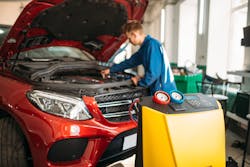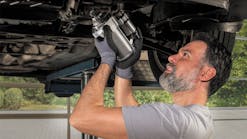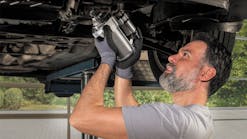Meeting the challenge of R-1234yf service
From lowering emissions to achieving better fuel economy, the ability to evolve vehicle systems and components has always been, and remains, central to modern-day initiatives to create a healthier environment. In the early 1990s, as scientists worked to identify significant contributors to the expanding hole in the ozone layer, chlorofluorocarbons (CFCs), including R-12 and hydrochlorofluorocarbons (HCFC), topped the list, prompting the need to adapt vehicle cooling systems. This development opportunity led to the widespread use of R-134a. With its zero-ozone depletion potential (ODP), R-134a became the standard for the automotive market by 1994, and it remained the legacy refrigerant until concerns over potential climate impact (i.e., greenhouse gas emissions) began to arise.
After being the standard for automotive cooling for more than two decades, R-134a found itself sharing the spotlight with the invention of R-1234yf, which delivered zero ODP plus a low (< 1) global warming potential. Moreover, with an atmospheric lifetime of only 11 days, R-1234yf offers similar cooling performance to R-134a with lower environmental impact. In 2011, the European Union began phasing out use of R-134 and mandated that by 2017 all new light-duty vehicles entering the market be charged with a <150 GWP refrigerant. In the U.S., wheels are currently in motion for similar regulations from the EPA. Leading the industry transition, General Motors achieved full conversion to R-1234yf systems by 2018, and other manufacturers in the U.S., Asia, Canada, and elsewhere have followed suit.Why does all this matter to the automotive aftermarket? A few numbers tell the story:
- 90 percent — the estimated number of vehicles manufactured for sale in the U.S. that use R-1234yf
- 80 million — the number of vehicles currently on the road in the U.S. charged with R-1234yf
- Four years — the average timespan before a new vehicle requires A/C service
- 15 million — the number of vehicles that come out of warranty annually
- 10 percent — the percentage of cars coming in for service of a R-1234yf system as of May 2021
While up until now vehicle service remained primarily for A/C systems charged with R-134a, the automotive aftermarket has reached the transition point. Given the global acceleration of OEMs to use R-1234yf, the scales are going to tip toward service demand for R-1234yf systems as well. At the same time, vehicles being manufactured since the early 1990s charged with R-134a remain on the road and, although their volumes are decreasing, service shops still need to be ready to recharge their A/C systems since there is no R-1234yf retrofit for these vehicles. Lastly, with the average lifetime of a vehicle currently at an all-time high of 12.1 years, shops can expect to be servicing both types of A/C systems for quite some time.
Avoid being trapped by the 'trickle'
Up until now, the number of R-1234yf cars coming in for service had been rather slow and steady, and for smaller shops especially, it may have seemed more economically strategic to refer the one or two trickling into a larger shop “down the street” that had the equipment and supplies on hand to service it. However, the demand for R-1234yf service is about to skyrocket. Shops still referring R-1234yf service elsewhere could quickly see a significant percentage of their business headed out the door. Refrigerant supply options do exist for service shops of all shapes and sizes that allow each one to implement a solution that keeps them competitive and offer the best fit for their customer base and budget.
Larger shops that perform at least 20 to 30 percent of their A/C services on R-1234yf systems should consider investing in an R/R/R machine, which is required for using cylinders. These machines cost on average of $5,000 to $7,000 and offer a range of benefits in terms of automation and safety checks. Service shops estimate that in terms of business they can keep in-house — as opposed to referring customers elsewhere — the machine “pays for itself” after about 30 vehicles are serviced. Higher-end machines also exist that offer dual use function for charging a vehicle’s A/C system with either R-1234yf or R-134a. EPA section 609 certification is required to purchase R-1234yf cylinders.
Smaller shops — those doing fewer than 20 percent of their service jobs on R-1234yf systems — or those without the cashflow to invest in an R/R/R machine — still have a viable option in keeping self-sealing cans of R-1234yf on their shelves. These cans allow you to do a single recharging job without waste. Use of the cans requires a one-time purchase of a reusable hose-gauge manifold set. A set meeting the needs of most shops typically costs $200 or less. No section 609 certification is required to purchase R-1234yf cans.
Important to know about R-1234yf
In terms of performance, R-1234yf and R-134a are very similar, and motorists rarely, if ever, notice a difference in vehicle comfort based the refrigerant type their vehicle uses. In terms of safety, R-1234yf is a mildly flammable A2L refrigerant. Users should know and follow all safe service practices to mitigate any risks.
The greater risk to service shops, technicians, and vehicles comes if you attempt to mix R-1234yf and R-134a or use one in a system manufactured for the other. Such cross contamination could damage the A/C system. Moreover, cars charged with R-1234yf fall under the U.S. EPA Clean Air Act, so it is illegal to use R-134a in a car manufactured for R-1234yf. Doing so could bring steep penalties upon the shop.
To help prevent these situations, R/R/R machines for R-1234yf cylinders and hose-gauge manifold equipment for R-1234yf cans use left-hand threads to prevent use with the right-hand-threaded R-134a equipment. Lastly, if in doubt, check the label under the hood of the vehicle or refer to its user’s manual, each of which clearly indicates the type of refrigerant system.
It is clear shops will need to maintain both R-134a and R-1234yf charged vehicles for a while, and a ready, ample supply of both exists to meet the demand. However, with the fleet size of R-134a waning, and the number of R-1234yf vehicles entering the automotive aftermarket growing in leaps and bounds, it’s inevitable that shops will be performing more and more of their A/C services on R-1234yf cars. Now is the time to start implementing the best R-1234yf solution for you and ensuring the customers who came to you for service stay with you for service.



